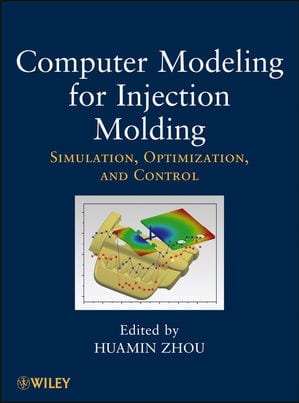 Computer Modeling for Injection Molding: Simulation, Optimization, and Control
Computer Modeling for Injection Molding: Simulation, Optimization, and Control
Huamin Zhou (Editor)
ISBN: 978-0-470-60299-7
Hardcover
416 pages
€90.50
Click here for more information
Reviewed by Professor Roberto Pantani, University of Salerno
The book presents a rather complete description of the role that computer applications can play in injection molding: not only in the more traditional sense of solving the balance equations to describe the process variables (temperatures, pressures, flow rates and so on), but also in applying optimization models and algorithms to get relationships among input parameters and specific quality features, and in implementing control systems to reach a specific target and to keep it constantly. This comprehensive approach makes this book something completely new in the huge bibliography on injection moulding.
The book is divided into four parts. In the first part, “Background”, written exclusively by the editor, Prof. Huamin Zhou, the main characteristics of injection molding and its key challenges are briefly outlined. This part can be useful to a reader who approaches the process for the first time, because in a clear but concise way it touches all the significant aspects of the process, from the design of the mold and its conditioning system to the morphology development, to the aspects of process control.
In the second part, “Simulation”, the main balance equations with the corresponding boundary conditions are presented, together with the main constitutive equations. Next, a detailed review of the numerical methods for solving differential equations is reported. The following chapters focus on the simulation of the cooling phase and on significant aspects such as the development of shrinkage, warpage and morphology. The section closes with an interesting chapter on the simulation software in which, after describing the main commercial software, the main steps that must be taken to develop a software simulation of injection molding are listed.
The third part is devoted to “Optimization”. It consists of three very interesting chapters, all written with the contribution of Prof. Lih-Sheng Turng, in which a review is given of methods and optimization algorithms of general interest, beyond injection molding or other polymer processes. Nevertheless, in each chapter, examples of application of these methods to injection molding are described.
The fourth and final part deals of a subject of growing interest in injection molding: “Process Control”. This section, written with the contribution of Prof. Furong Gao, may be of great interest to the reader approaching the problem for the first time, because it illustrates several control strategies suitable for a process in which the variables strongly interact in a nonlinear way. The introduction to the last chapter is particularly explanatory of the difficulties that the quality control presents because of the dependence of the material properties on the process variables, of the batch to batch variability of the material to be processed, of the non perfect reproducibility of the moulding cycle from the machine point of view, of the difficulty in measuring the quality itself of the molded part.
All throughout the book, an effort is made to provide a description (both from the physical and the modeling points of view) of the phenomena that characterize and control the process and the quality of the product.
Overall, this book can be recommended for a reader interested in getting an overall idea of the contribution of computer science to injection molding, or to a researcher looking for an updated review of the latest applications of numerical techniques to this technology.

















